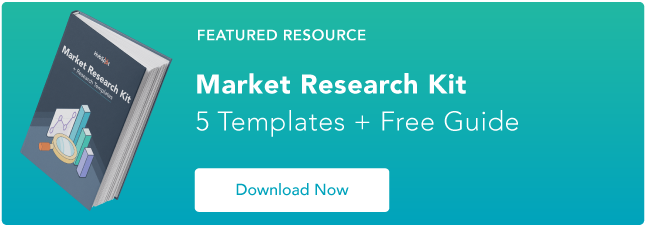Target Audience: My Tips for Finding the Perfect Fit [+ 5 Campaign Examples]
Recently, I noticed that every time I Google a product or service I want to buy — let’s say, available apartments for rent — I start getting ads on Instagram and Facebook from several companies offering this service.
Recently, I noticed that every time I Google a product or service I want to buy — let’s say, available apartments for rent — I start getting ads on Instagram and Facebook from several companies offering this service.
I’m sure you can relate, too! This happens because we are those companies’ target audience.
Every product and service has a target audience, no matter how niche. And the only way a company can sell its product is if it caters its marketing strategy to its target audience.
Understanding target audiences is key to the success of any marketing campaign because consumers will feel as if they connect with your brand.
If you‘re unsure how to find your target audience, here’s what you need to know.
Table of Contents
They are also used to define the buyer persona of a business, as well.
Buyer personas are a representative overview of a business’s ideal customer drawn from data that makes up a target audience.
Some of these demographics and behavior areas are:
- Location
- Age
- Gender
- Employment
- Income
This information helps understand customers and how they make purchase decisions. Targeting a specific audience will help your campaigns reach the people who will relate most to your company’s message and products.
Always make sure to understand the difference between target audience and target market. While similar, their difference is critical for marketers.
Essentially, you can describe your target market by finding your target audience. If a target market were “marketers aged 25-35,” the target audience would be “marketers living in Boston, Massachusetts aged 25-35.”
Types of Target Audience
When we talk about types of target audiences, we‘re talking about more ways to define who you’re creating a campaign for. You can segment your audience into groups or define them further using categories such as:
Demographics
Demographic segmentation divides a market into smaller categories based on variable characteristics such as age, race, gender, marital status, income, education, and nationality.
This method is one of the most common ways to define a target audience because it’s easy to acquire the data you need through censuses, market surveys, and analytical tools.
Each demographic factor can significantly influence consumer behavior and product preferences. For example:
- Age. Product preferences can vary significantly between different age groups. A digital app might be more popular among Gen Zers, while luxury cruises would likely appeal more to older retirees.
- Gender. Marketing strategies might differ when targeting men or women, as they may have different preferences in areas such as fashion, beauty, or health products.
- Income. Economic status influences buying power, which affects what kinds of products or services consumers can afford.
Purchase Intention
This refers to groups of people looking for a specific product and wanting to collect more information before doing so.
Some examples include consumers buying a new laptop, vehicle, clothing, or television. This data is necessary to see how you can better direct your messaging to your audience.
Lifestyle
This involves categorizing consumers according to their interests, activities, opinions, values, and overall lifestyle.
This classification is less straightforward than demographics because it deals with subjective internal characteristics that can be harder to measure.
Lifestyle often reflects how consumers see themselves and what they aspire to.
For example, whether someone frequently participates in travels, sports, or attends cultural events can influence what types of products and services they’re interested in.
Similarly, a consumer’s beliefs in areas like environmental consciousness, politics, or preferences for domestic products can affect their purchasing decisions.
Interests
This is data about what people are into, like hobbies. Knowing this data helps you connect with your audience in a relatable way and unearth buyer motivation and behaviors.
For example, when the weather is warmer and road racing season begins, consumers who enjoy road biking as a hobby are likely most interested in new road bikes in the spring.
For example, suppose you find many potential audiences interested in traveling. In that case, you can figure out how to use that message in your marketing campaign to appeal to more potential buyers.
Subculture
These are groups of people who identify with a shared experience. An example of this would be a specific music scene or genre of entertainment.
People define themselves by subcultures; companies can use those cultures to understand who they’re contacting.
An example of reaching a subculture is thinking of how it relates to your business, especially if you have a large potential audience.
For instance, Netflix markets to their subcultures, people who watch specific types of content, such as parents. They use social media accounts directed to those subcultures — like Netflix Family.
As you’ve probably guessed, coming up with a target audience involves some research, which goes into fleshing out who you want to reach and how you can get there in a way that stands out from competitors.
If you’re ready to find yours, follow these steps below.
1. Use HubSpot Analytics to learn more about your customers.
According to HubSpot’s 2024 State of Marketing report, only 65% of marketers have high-quality data about their target audience, leaving 35% who don’t know their audience definitively.
If you don’t know enough about your target audience, HubSpot Analytics is an excellent tool for obtaining demographic details about them, as well as real-time analytics about your marketing campaign’s performance.
Here is some information you can find in the analytics dashboard.
Traffic Analytics
This tracks your website’s performance and other digital assets. It provides metrics like page views, unique visitors, bounce rates, and session duration.
You can also see your traffic sources (organic, direct, referrals, social media, etc.), which helps you understand which channels are driving the most engagement.
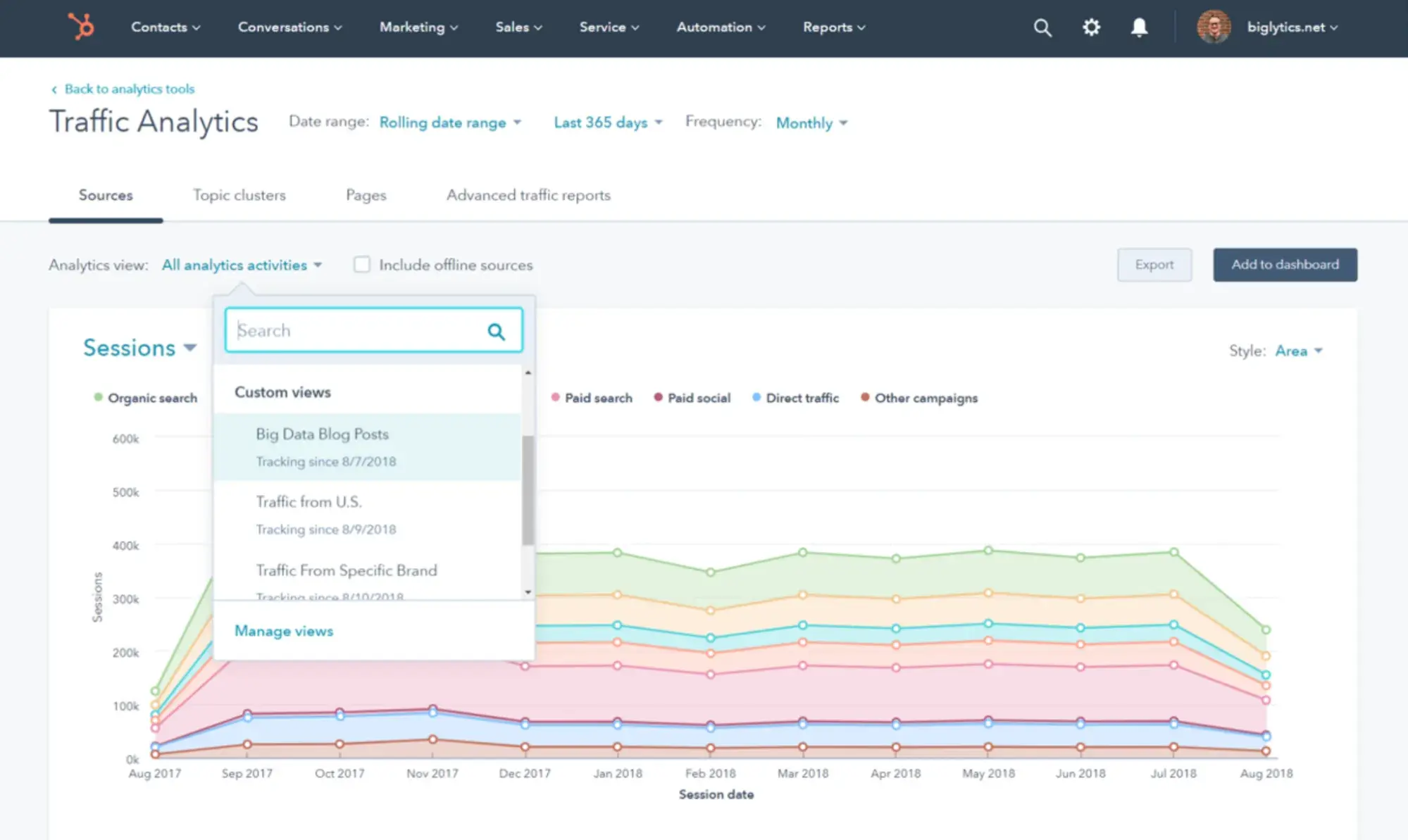
Conversion Analytics
HubSpot allows you to track how well your landing pages and other conversion tools are performing. This includes data on form submissions, lead conversions, and the effectiveness of different calls-to-action (CTAs).
You can also analyze the conversion paths to optimize the steps your visitors take from entering the site to becoming leads to becoming paid customers.
Campaign Analytics
HubSpot allows you to measure the performance of each marketing campaign you’re running. This includes impressions, clicks, conversions, sales, and ROI, helping you to gauge which campaigns are the most effective and why.
Custom Reports
HubSpot allows you to create custom reports that fit specific needs. You can pull together various data points from across marketing, sales, and service platforms to create comprehensive reports to meet your unique business requirements.
Pro tip: If you’re not using HubSpot analytics, you can connect your website to Google Analytics to find demographic data about your target audience, including their age, gender, interests, lifestyle, nationality, and more.
2. Create a reader persona to target blog content.
With reader personas, you‘ll never forget who you’re writing for. Your reader persona should be nearly identical to your buyer persona because your blog should contain content that will be useful for your readers.
For example, as a marketer and tech enthusiast, I’m always on the lookout for reputable blogs about digital media and technology trends.
The difference between a reader persona and a buyer persona is that a reader persona generally focuses on the challenges your persona might face. How can you write content that solves those challenges?
For example, if one of the challenges you’ve identified in your buyer persona is “Marketing Mario wants to find a solution to low ROI on ad spending,” you can use a reader persona to think of content surrounding helping that challenge.
Pro tip: If you’re unsure about the challenges your reader persona is facing, you can ask them using tools like polls, quizzes, surveys, or other forms of interactive content. Analyze the responses you receive and then create content to solve their pain points.
3. Look at social media analytics.
When are your followers most engaged with your social media channels?
Is it when you post a funny meme on Instagram or create a poll on Twitter?
By looking at these questions, you can get a couple of clues into what content your audience is interested in, thus filling in one of the parts needed to find a target audience.
Every social channel is different and has a diverse audience, so it’s essential to look at your analytics across all social platforms.
For example, as a Gen Z, I use Twitter (now X) more than I use Facebook, which is consistent with reports that Twitter tends to have a younger audience, while Facebook tends to have an older one.
On the same note, Twitter is based on short-form content; on Facebook, you can post long-form content and videos.
Instagram is a visually-based social media platform, so visually appealing content would thrive on the channel. Knowing these things, you can begin to plan your strategy accordingly.
Analytics can tell you who is looking at your profile. Moreover, they can tell you what’s working and not working content-wise. By posting content your audience is more interested in, you can gain followers in your target market.
Pro tip: Each social platform has unique features to help you reach and engage with your target audience. Instagram has Stories, Reels, and polls, and YouTube has Shorts. Use these features and check your analytics to see how well they’re working.
4. Use Facebook Insights.
If you have a Facebook page, Facebook Insights is precisely what you need. Facebook gives every page a vast set of insights for free.
These insights work similarly to Google Analytics — you’ll receive critical information required to create a target audience.
You can see who and from where your visitors are by accessing the People tab on your Insights dashboard.
Below is an example of how Facebook shows location demographics. It seems that the primary location is the East Coast, so it’s safe to say that part of the target audience for this page is located in cities on the East Coast.
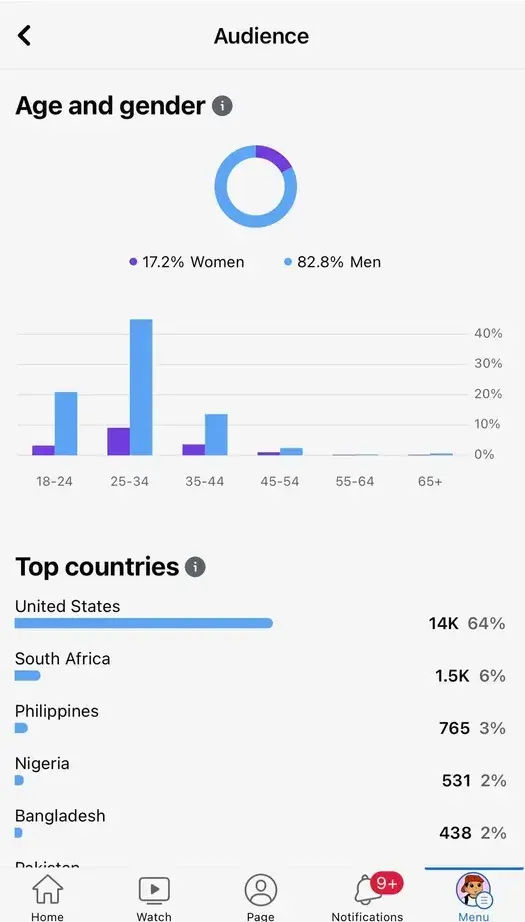
Other areas Facebook focuses on include interests and integrations with other social media platforms, like Twitter. The insights report tells your audience’s lifestyle, such as if they purchase items online.
Insights like these can help you far into your campaign planning, past finding a target audience, so it’s a valuable tool to check on now and then.
Pro tip: Use the detailed demographic information available on Facebook Insights to segment your audience and customize your marketing campaigns.
Tailor your content, messaging, and advertising strategies to match the characteristics and preferences of different audience segments.
For instance, if the insights reveal a significant portion of your audience is located on the East Coast, consider creating region-specific promotions or events.
5. Check up on website performance.
Monitor your website’s best and worst-performing content areas. Many of your target audience will use your website as their introduction to your company, so sprucing up what interests them is a great way to attract more members.
By looking at what blog posts or landing pages are captivating your audience, you can repurpose content that isn’t and promote the content that is.
For instance, if your blog post about email marketing was a hit with audiences, share it on your socials to expand your reach.
Pro tip: You may notice that some pages are doing better than others. While this can indicate that your readers are more interested in a certain topic, it’s also possible that they’re not finding the badly-performing pages on your site.
So, implement a streamlined navigation menu that prominently features your latest content and popular content so visitors can easily find them.
6. Engage with social media audiences.
Interacting with social media followers is so important because they‘re your audience. When you create your buyer persona, they’re the users you should look to. Remember to remember this step if you don’t have social media accounts yet.
Ask your followers what they want to see, and use tools like Instagram Stories and replies to get their response for how/what you’re doing.
Whatever engagement you get, positive or negative, can influence how you attract more audience members.
For example, try tweeting something that invites a CTA, like “Send us a picture of your favorite outfit to wear with our new hats!” This evokes a response, responses you can analyze the language of and imitate to grow your audience.
Pro tip: You can maximize engagement by incorporating user-generated content (UGC) into your social media strategy. When followers respond to your CTAs, like submitting pictures or comments, feature these contributions in your posts, Stories, or as part of a community highlight reel.
This signals to your audience that their input is valued, which enhances loyalty and attracts new followers.
Check out this example of how Stanley demonstrates engaging with social media audiences can help you build your audience.
1. Nike
Nike, the world’s largest supplier of athletic shoes and apparel and a major manufacturer of sports equipment, is a powerhouse at branding with its iconic Swoosh logo and its slogan “Just Do It.”
I believe that a huge part of Nike’s success is due to its ability to target the right audience via online platforms.
On Instagram, Nike showcases its products and lifestyle through visually compelling imagery and videos featuring athletes and influencers.
It also uses Instagram’s features like Stories and Reels to share content from brand partnerships and product launches.
This is effective because Nike’s target audience on Instagram is primarily young adults, athletes, and fitness enthusiasts who want to keep up with the brand.
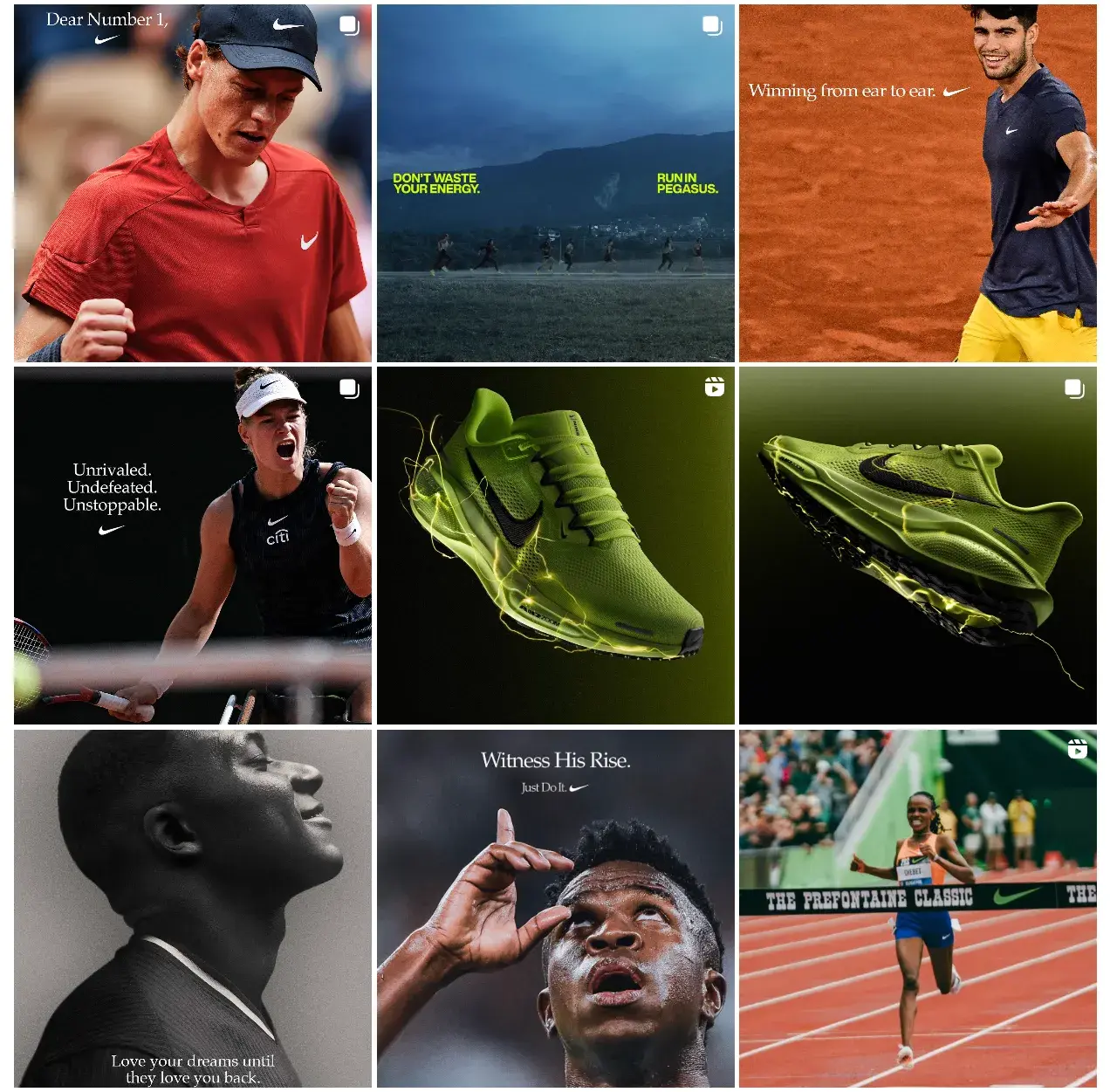
On LinkedIn, however, Nike’s audience consists mostly of business professionals, potential employees, and industry partners. So, the company shares posts about its corporate culture, sustainability efforts, charitable acts, and job openings.
It also publishes articles and updates on its corporate social responsibility initiatives and industry insights.
What I like: I like how Nike’s partnerships with different athletes across several sports not only allow these athletes to share their success stories but also target sports enthusiasts worldwide.
Instead of honing in on one sport, Nike reaches upcoming athletes across several disciplines globally by platforming their favorite star athletes.
2. Coca-Cola
Coca-Cola, the company that makes the beverage that I drink too much of, has clearly defined its target audience segments and creates content that caters to them.
Since it knows that Facebook is mainly used by millennials and older people, as opposed to Gen Zs, it posts family-friendly content, community stories, and nostalgic ads to its 109 million followers on the platform.
It also runs interactive campaigns and polls to engage a broad audience.
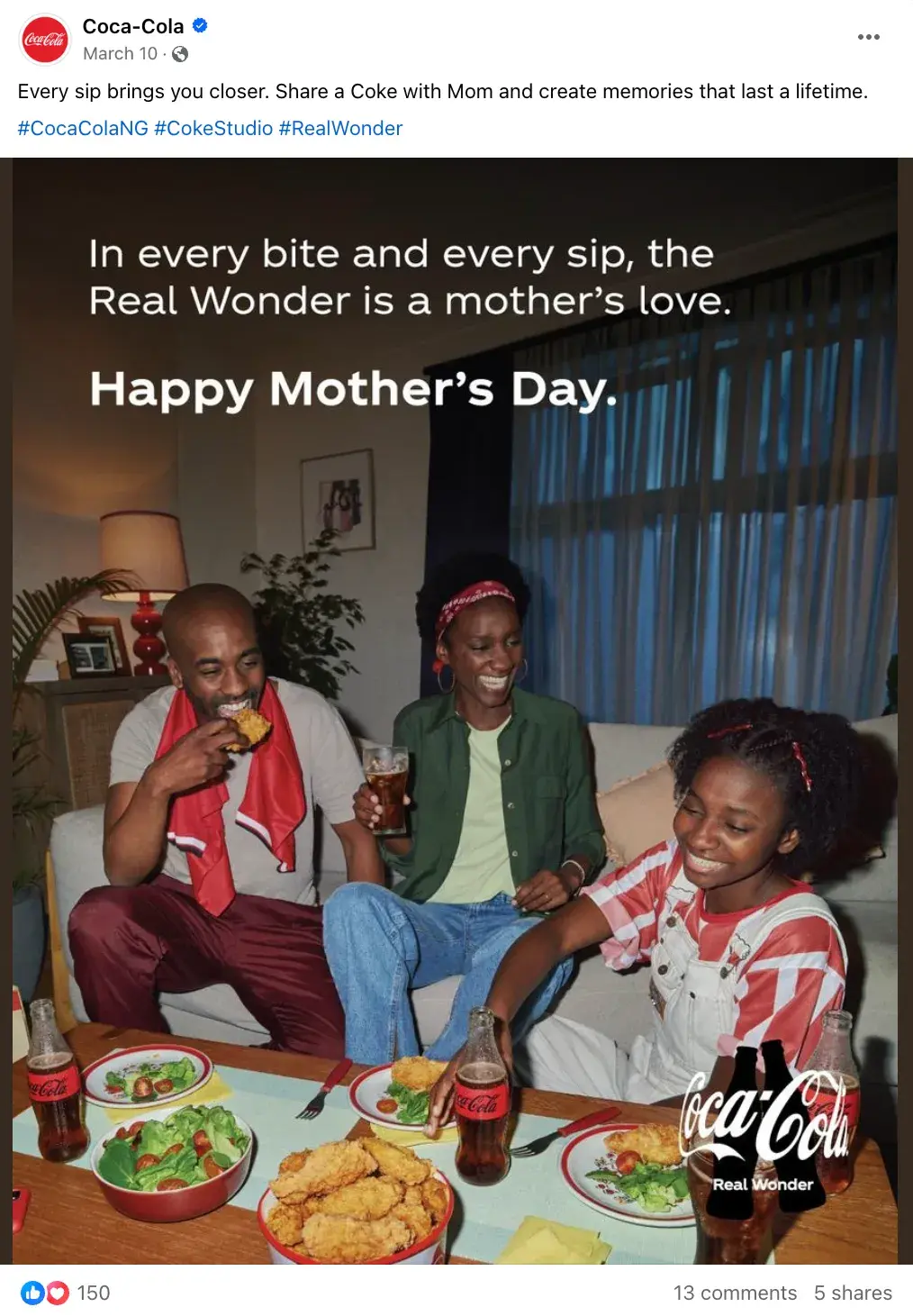
On Twitter (now X), Coca-Cola’s target audience shifts to younger, tech-savvy people, many of whom follow trends. So, it uses its Twitter profile for real-time marketing, trending topics, and customer service.
It posts stunningly shot videos that center sports teams, like the NFL, and artists like Jon Batiste, Camilo, and Cat Burns via Coke Studio. It also engages with its followers through hashtags, polls, quick updates, and responses to current events.
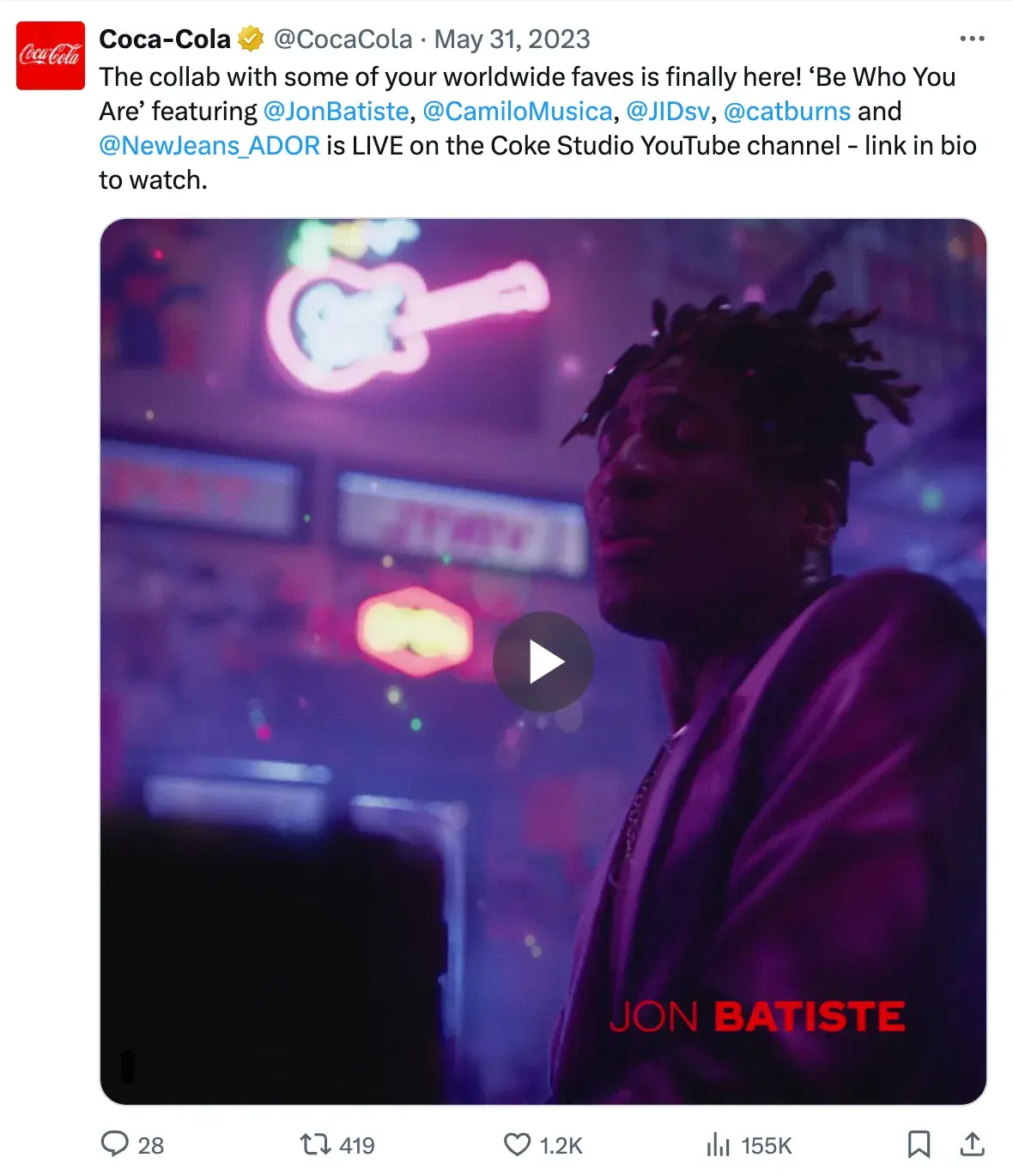
What I like: I like that Coca-Cola cleanly splits its target audience segments and uses Facebook and Twitter to reach them where they’re at. The audience on Facebook vastly differs from those on Twitter, yet Coca-Cola expertly creates content that resonates with both groups.
3. Sephora
Sephora is a French multinational retailer of personal care and beauty products. Featuring about 3,000 brands, along with its own label, Sephora sells beauty products, including cosmetics, skincare, body, fragrance, nail color, beauty tools, and haircare.
This means that its target audience is mostly beauty enthusiasts, makeup artists, and DIY beauty fans, many of whom are Gen Z.
Sephora targets these people through Instagram and YouTube.
On Instagram, the company focuses on sharing short (or sped-up) makeup tutorials, product showcases, and collaborations with influencers and celebrities like Simone Biles, Sydney Sweeney, and Mona Kattan, all of whom young people are familiar with.
The company uses Stories for behind-the-scenes content and Reels for quick beauty tips.
This is a smart move by Sephora, considering that short-form video is currently the best online content format, offering the highest ROI and will see the most growth in 2024.
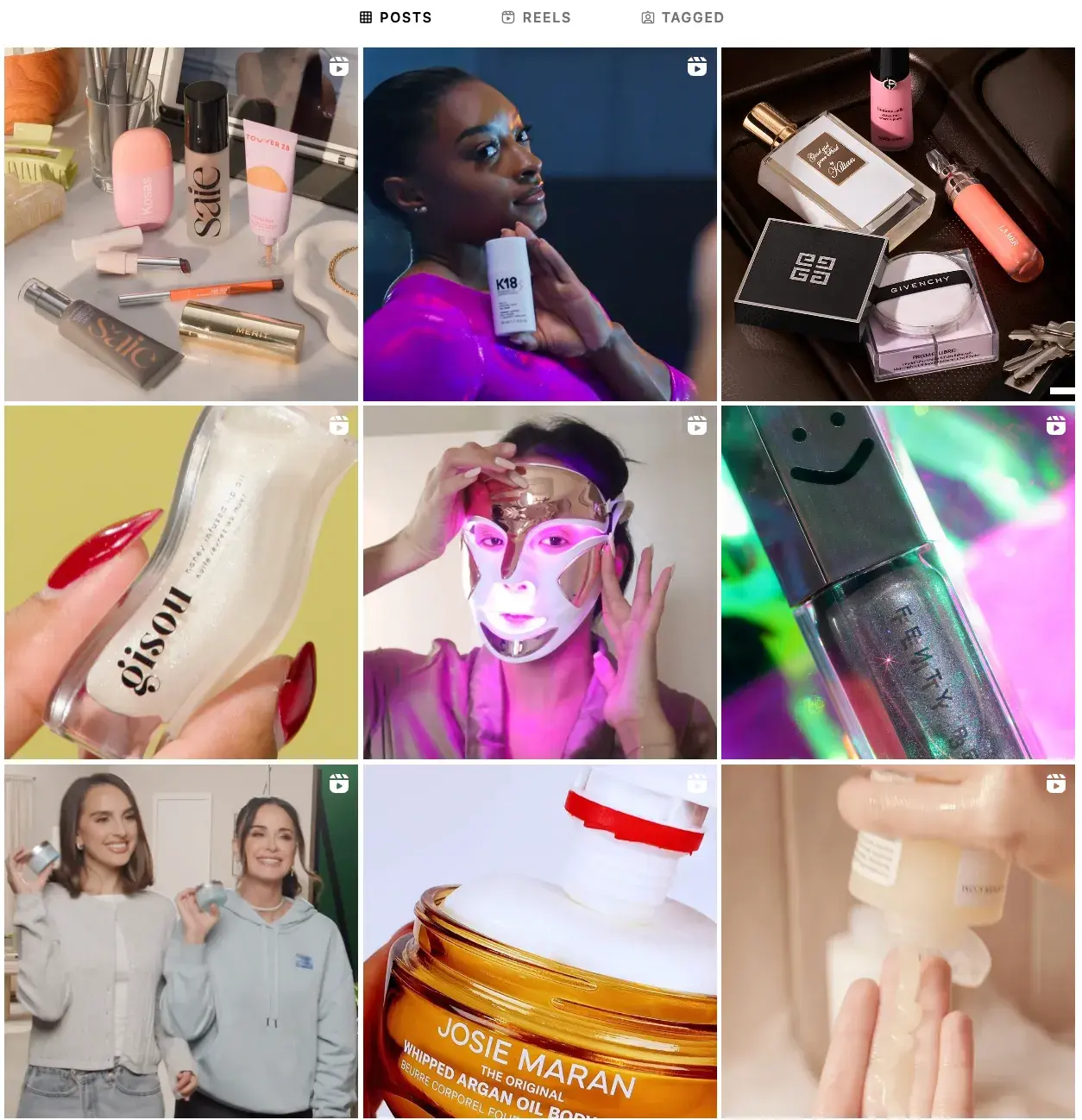
On YouTube, Sephora moves from short-form videos to longer content, such as detailed makeup tutorials, skincare routines, and product reviews.
It collaborates with beauty influencers and founders like Olamide Olowe (Topicals), Lady Gaga (Haus Labs), and Diarrha N’Diaye (Ami Colé) for extensive product demonstrations.
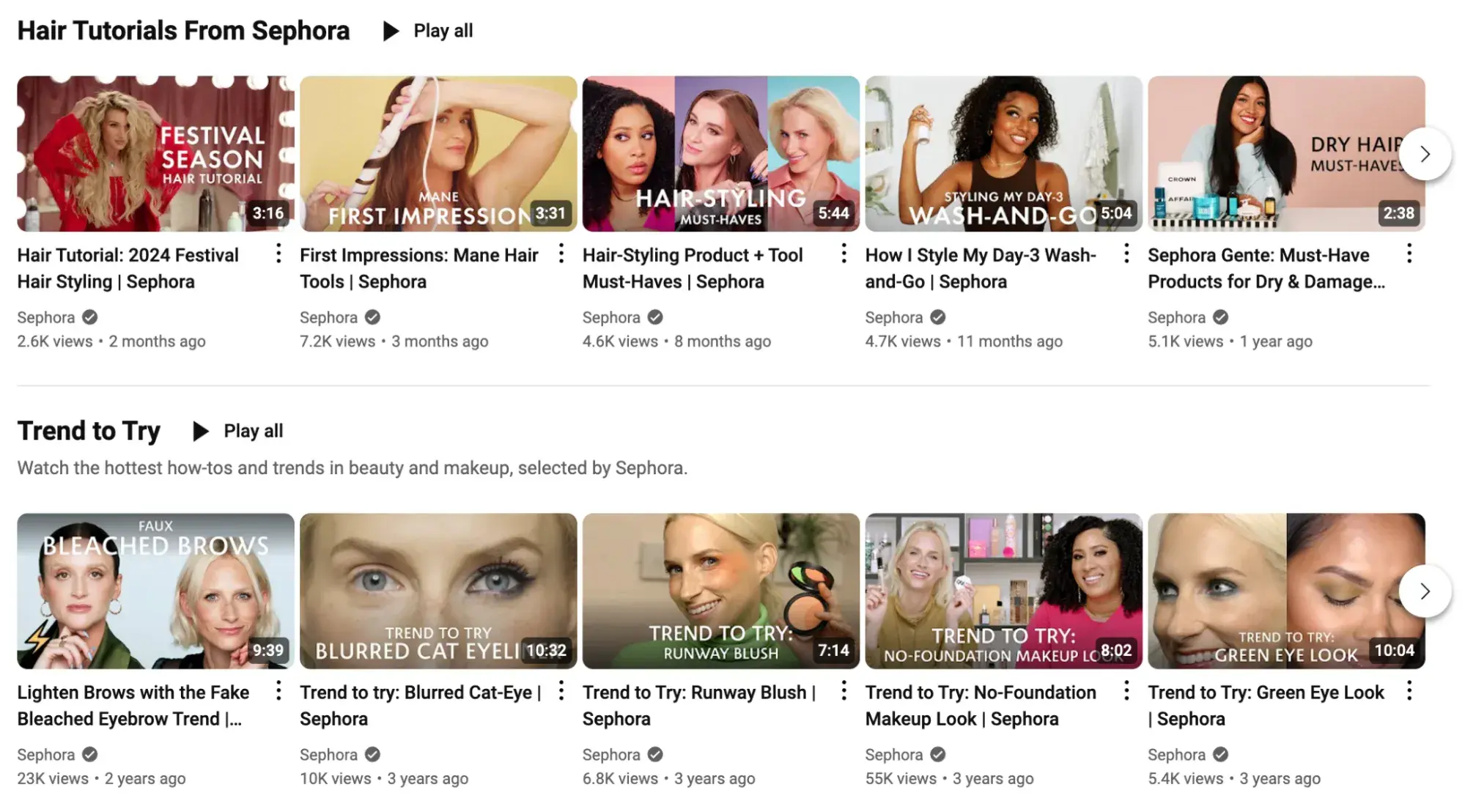
What I like: While Sephora’s target audience remains constant across all social platforms, I love how the company expertly uses each platform’s features to adapt its content to meet users’ expectations.
4. Red Bull
Red Bull is an energy drink originally based on a Thai drink called Krating Daeng, adapted to suit Western tastes.
The product, known for its distinctive slim silver can and its slogan, Red Bull gives you wings, is marketed globally as a drink that increases performance, concentration, and reaction speed, and enhances mental and physical vitality.
Red Bull takes a unique approach to marketing in that, instead of posting ads about the drinks it produces, it cultivates a strong presence in sports like Formula One racing, extreme sports, football, and eSports.
The brand is also known for its high-profile events, such as the Red Bull Air Race, Red Bull Crashed Ice, and music festivals.
On Instagram, Red Bull targets extreme sports fans, adventure seekers, and young adults by posting high-energy, visually stunning content featuring extreme sports, stunts, and events.
It also uses Stories and Reels to capture the brand’s adrenaline-pumping essence.
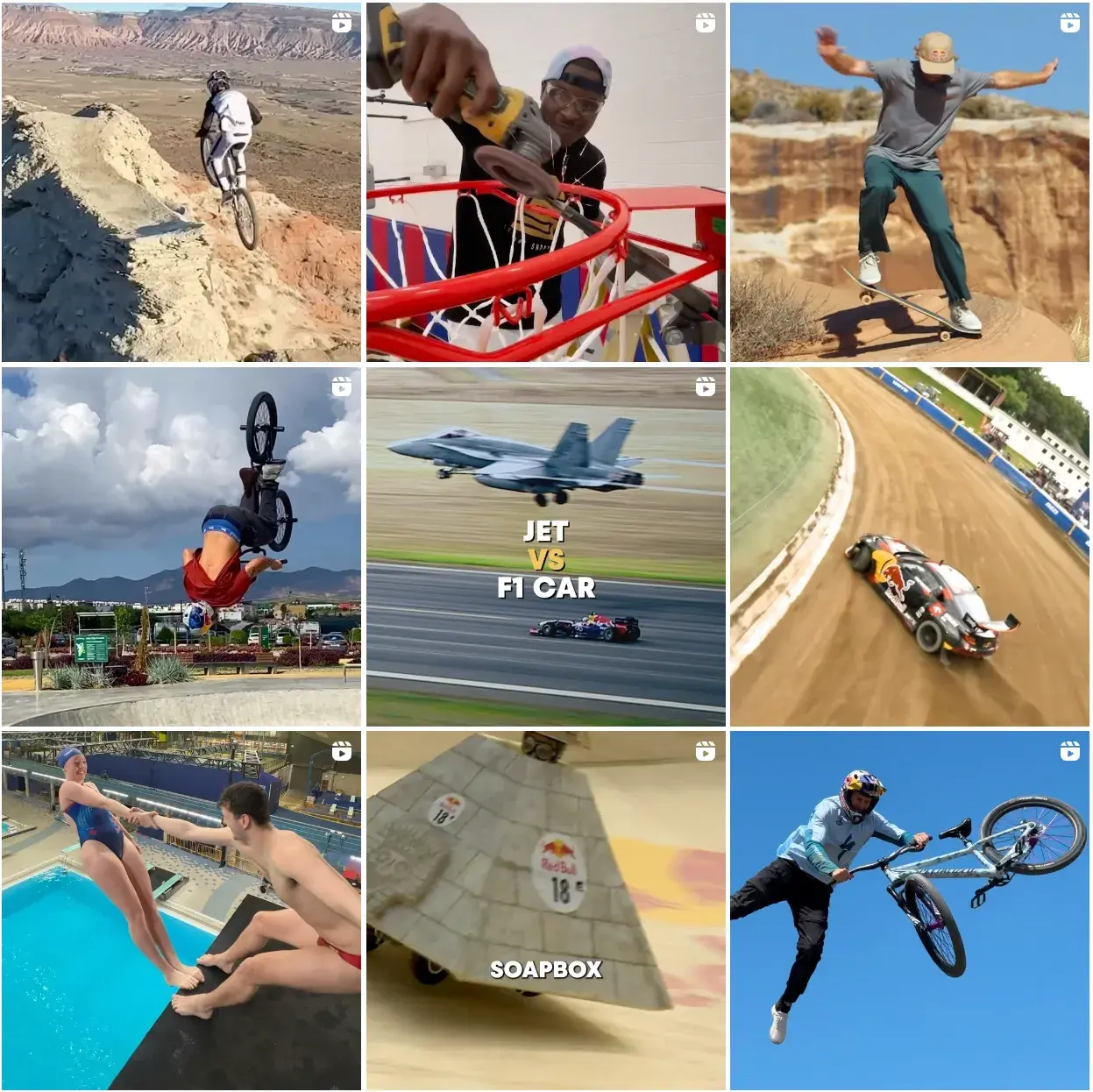
Red Bull’s YouTube channel is an extension of its Instagram page, featuring longer videos of extreme sports events, documentaries, and athlete profiles.
What I like: Instead of going the regular route and posting beautiful videos of its products, Red Bull decided to engage in experiential advertising. Embedding itself into the world of extreme sports, Red Bull is able to use these athletes with otherworldly abilities as its representatives.
5. Patagonia
Patagonia is an American outdoor clothing company known for its commitment to environmental sustainability and ethical manufacturing practices.
While it originally began as a small company that made tools for climbers, Patagonia grew steadily due to its high-quality and durable products, as well as its activism on environmental and social issues.
Knowing that its target audience largely comprises outdoor enthusiasts and environmental activists, Patagonia uses Instagram to share stunning outdoor photography and videography, stories of adventure, and environmental activism.
Its content highlights sustainable practices and encourages followers to engage in conservation efforts.

On LinkedIn, Patagonia shares updates on its corporate social responsibility initiatives, sustainability reports, and company culture.
It also posts articles on environmental impact and business practices to inform people and attract like-minded professionals.
What I like: Patagonia knows that its audience doesn’t just comprise people who want to buy outdoor apparel; it also includes people who are passionate about the environment.
I love how the company’s online content caters to both groups of people equally. It gives its followers exciting outdoor activity ideas while spurring them to do something beneficial for the environment.
Identify Your Target Audience Like a Pro
I was able to see the ads from companies offering rentals because I embodied everything about their target audience, from demographics and purchase intentions to lifestyle and subculture.
Understanding your target audience gives you an idea of how to market to, engage with, and segment your customers.
If you’re having trouble identifying and defining your target audience, here’s a market research kit that can help you. Inside this kit, you’ll find an instructional guide, SWOT analysis template, survey template, focus group template, and more.
Whether you’re a new startup or a long-existing enterprise, this kit will help you conduct deep market research and competitive analysis to familiarize yourself with your prospective buyers.
Editor’s note: This post was originally published in January 2020 and has been updated for comprehensiveness.
![]()



![→ Download Now: Market Research Templates [Free Kit]](https://no-cache.hubspot.com/cta/default/53/6ba52ce7-bb69-4b63-965b-4ea21ba905da.png)
